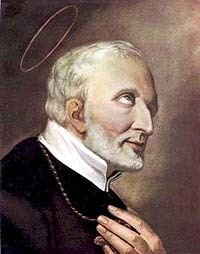 | ||
Bilocation, or sometimes multilocation, is an alleged psychic or miraculous ability wherein an individual or object is located (or appears to be located) in two distinct places at the same time.
Contents
The concept has been used in a wide range of historical and philosophical systems, ranging from early Greek philosophy to modern religious stories, occultism and magic.
History
The concept of bilocation has appeared in early Greek philosophy, shamanism, paganism, folklore, occultism, magic, the paranormal, Hinduism (as one of the siddhis), spiritualism, Theosophy, the New Age and mysticism in general, as well as Christian mysticism and Jewish mysticism.
In religion and mysticism
Several Christian saints, monks and Muslim sufis are said to have exhibited bilocation. Among the earliest is the apparition of Our Lady of the Pillar in the year 40. Other Christian figures said to have experienced bilocation include St. Alphonsus Marie De'Liguori (Founder of Redemptorist Congregation), St. Anthony of Padua, Ursula Micaela Morata, St. Gerard Majella, Charles of Mount Argus, Padre Pio, St. Severus of Ravenna, St. Ambrose of Milan, María de Ágreda, and St. Martin de Porres, María de León Bello y Delgado, as well as Pope Cyril VI of Alexandria. St Isidore the Laborer claimed to be praying or attending to Mass in Church while at the same time plowing in the fields.
Witchcraft
In the 17th century, persons accused of witchcraft were reported to appear in dreams and visions of witnesses. The trials at Bury St. Edmunds and Salem included this "spectral evidence" against defendants. Matthew Hopkins described the phenomenon in his book The Discovery of Witches.
Modern
The English occultist Aleister Crowley was reported by acquaintances to have the ability, even though he said he was not conscious of its happening at the time.
Bilocation figures heavily in David Lynch's film Lost Highway (1997) and Thomas Pynchon's novel Against the Day (2006).
A mystical story that involved Soviet author Yevgeny Petrov served as inspiration for the film Envelope (2012) starring Kevin Spacey.
Skepticism
Skeptical investigator Joe Nickell has written that there is no scientific evidence that bilocation is a real phenomenon and that cases are often from anecdotal reports that cannot be verified. Nickell listed self-delusion, hoaxing and illusion to explain alleged cases of bilocation.
